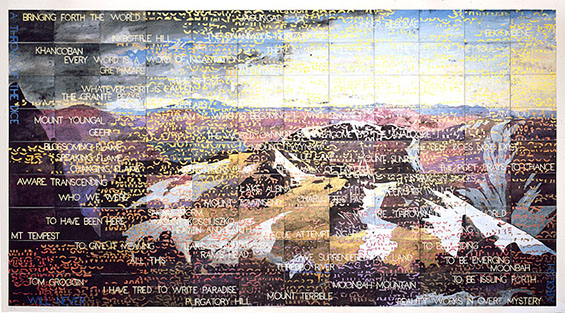
The poet J. S. Harry died two weeks ago, on 20 May 2015, at the age of 76. She was the author of seven books of poetry, including The Deer Under the Skin (1971), one of the first titles in the epochal UQP Paperback Poets series; A Dandelion for Van Gogh (1985); The Life on Water and the Life Beneath and Selected Poems (1995); Sun Shadow, Moon Shadow (2000), and Not Finding Wittgenstein (2007). These books won a number of prestigious literary prizes, including two NSW Premier’s Literary Awards and the Age Poetry Book of the Year Award.
As the use of initials in her writing name suggests, Jann Harry was a very private person – when I first met her, her face was veiled by her long hair, which fell all around her head. As she had a strong nicotine stain on her fingers, I wondered how she could smoke without setting fire to herself. That kind of quizzical impression remains, for me, one of the dominant features of her poetry. Despite the sense of privacy, Jann could be expansive once the conversation had been established – she was gentle, kind, solicitous and ever so curious (the turn of phrase could easily have been hers) – she would probe, enquire, pursue – everything seemed interesting to her. And she had another quality which was extraordinary, and which, along with her shyness and curiosity and her precision in language, is such a powerful presence in her poetry: this was her attentiveness to the life of animals. She was devoted to the possums that gathered by her back door for their nocturnal feed, and to the birds in the park just up from her house in the lower reaches of Paddington, near to Rushcutters Bay. Their feeding times, and the shopping for fresh but rejected food that this involved, determined her day. I imagine there must have been an air of devastation among the natural inhabitants of her suburb when she became too ill to continue her duty of care.
If one were to make a single claim for Harry’s significance in Australian poetry, I think it should be that she was our first and foremost ecological poet. She wasn’t a ‘nature poet’, in the way that this term is used to describe poets of an earlier generation like David Campbell or Judith Wright. Though she shared the visual acuity of the one, and the passion of the other, her poetic idiom is distinctively contemporary. Her mastery of the line, the pause, the shift in emphasis or perspective, her control of tone, above all her interest in language, not only for its descriptive or creative powers, but as a physical presence in the world, and a mutable one at that – these give her the flexibility, and the range, to evoke the order (or disorder) of things in her poems, and not just the things themselves. Her details, which are so finely observed, lead to other details, relationships, conflicts, stories, parables, meditations on language and history, in a movement outwards from nature to everything which impinges on it, including the imagination and its contents. It is this movement, this expansiveness, which I think of in describing her achievement as ecological.
Harry’s ability to evoke not just the detail, but the world to which the detail belongs, is apparent in the title poem of The Life on Water and the Life Beneath, which follows a man rowing over a country town that has been drowned by a newly-built dam:
For months the paddock magpies gurgled
in gums they could not
visit earth beneath, for worms.
Feeding patterns altered.Temporarily
those magpies fed
in space;it was miles
to other trees that drew from peckable ground.
School was moved
from the riverflat to the lower hills
to squat with the hares in the upland grass
above the valley’s
final drowning. Easy
to move a one-room demountable.
When the magpies moved
it was their absencerather than
their act of moving out
that was noticed. Absence audible
as a rubber band stretched tight
that your ears
anticipate
the snapping or pinging of.
Often, for Harry, it is what is not there in the scene, that which has been driven out of it or destroyed, that is as strongly felt as what is. This applies to imagined entities too, which have their rightful place in the scene, though not seen – it is the reason for her continued argument with the positivist philosophers of language. ‘She thought the mind was / the most beautiful / thing she had never felt’ is how she puts it in the poem ‘Celia’.
Harry’s titles often act as invitations to enter the space she creates in her poems – ‘it looks nice and quiet down there’, ‘Tell Me What You See Vanishing’. Or they may be openings to a story – ‘Hesse Meets Jung Some Miles from Gundagai’. Or they suggest the title of a painting – ‘Woman as Jug / Blue Lady Poem’, ‘showing ourselves to the neighbours’ children, Warragamba’. Sometimes it is their enigmatic quality that appeals, ‘Routine of Durable Fowls Would Drive Him Mad He Says’, or ‘losing a lover / discovering a place to keep seagoats’. One of her most powerful poems is introduced with a cliché, ‘the baby, with the bath-water, thrown out’ – it is about a woman who has a miscarriage in the shower, and the destruction of the relationship which follows, ‘Each pair of eyes / reminds the other / of an eyelessness // that joins them.’
Another poem carries the title ‘Navigating Around Things’, which is a good description of what Harry does: it begins with a flock of cardboard cartons abandoned under a tree in a park, then moves from them to galahs to summer grasses to cantering horses (‘They are making frost breaths / in the oven of their bodies’) to an unemployed young stockbroker sacked after the financial crisis, who is taking their photograph, to the eels and ducks in the pond nearby. Then this:
In the season of the small ducks,
when these day-old downy venturers
first staggeronto the lilyleaf plates,
& wo
bb
le
off
raw
live
into the astounding
truths of the water,
the large eels suck like centripetal force
that drags the water
out of the bathtub& suddenly
in the dying dark
alone down an eel
goes a trustful fluffball.
Typically, though not always (she has lions and pelicans and camels too), Harry’s starting point for the process of navigation and expansion is the vulnerable or fugitive creature – deer, cockroach, lizard, spider, ant, mosquito – or the transient effect of clouds or light or misty rain. It’s not easy to capture these delicate effects with precision and economy, but this is her great skill.
There is a tendency to see the Peter Henry Lepus poems, which appeared for the first time in The Life on Water and the Life Beneath, then in Sun Shadow, Moon Shadow, and then fully in Not Finding Wittgenstein, as the climax of Harry’s achievement. This sequence of poems, which has a rabbit as its hero, and was written over a period of more than twenty years, seemed to offer a licence for Harry’s imagination to roam – certainly it opened to her poetry what must have seemed to be a limitless landscape, from the Australian outback to Antarctica to Calcutta, across the desert sands of Iraq and beyond, a landscape upon which to combine the diminutive point of view with the widest possible range of implication. The sequence itself seemed limitless – Harry was still writing Peter poems in her illness. But it would be a mistake to see this unfinished sequence of poems as a late flowering. The qualities that drive Peter and his companions – a spider and a camel – and those of his kind that he meets along the way, like the imperious Chairman Miaow, a cat as white as the moon, are exactly the qualities that animate the earlier poems too.
The rabbit is the real key to the generative power of the Peter Henry Lepus poems – the figure is perfectly suited to express the quizzical, curious, naive and yet knowing innocence of the poet herself. Harry was worried that the estate of Beatrix Potter might claim her Peter as theirs, but this too became an opportunity – to invent an elaborate genealogy for Peter Henry Lepus which stressed his creole ancestry, his immigrant status, and his pronounced sense of deracination and disorientation. He too was the product of writing – for Harry language was primary – and with a consciousness of his origins that Potter’s rabbit could never have had. The first Peter Henry Lepus poem begins –
Like a pirated edition
of the book of himself
the eponymous Peter Henry Lepus
gets dumped in Australia.
The landscape in which he first finds himself is one ravaged by disease. Later it will be a landscape ruined by war. There is a tough-minded realism to Harry’s ecological concern that makes the quality of curiosity and wonder in her poetry all the more remarkable.
This week Sydney Review of Books features its first ever piece of reportage. ‘Don’t Go To Jolo’ is Part One of Matthew C. Thompson’s account of his recent visit to the dangerous Sulu region of the Philippines, where terrorist attacks are a regular occurrence. As Thompson explains, the Sulu Archipelago has a long history of unrest, dating back centuries to when the Spanish were the colonial rulers. In this first instalment, Thompson travels through the region under heavily armed guard in the company of the former mayor of Lamitan City, Roderick ‘Oric’ Furigay, and tries to make sense of the array of radical groups and Islamic militias keeping the region in an ongoing state of instability:
The War on Terror that George W. Bush declared in 2001 (in which he included the Philippines as one of three fronts, the other two being Afghanistan and the Horn of Africa) may feel to America like a bad dream that is dragging on too long, but empires have come and gone during the dream of Jolo and its surrounds. The War on Terror is nothing new in the Philippines. It’s more a state of nature.
Our second article is a review of one of this year’s most anticipated novels, Sarah Hall’s The Wolf Border. James Bradley admires Hall’s visceral, emotionally powerful and politically charged writing, and interprets her book as part of a wider literary movement in Britain that is addressing our precarious and changing relationship with the natural world:
Taking its title from the Finnish term susiraja, which denotes the boundary between the region of the capital and the rest of the country and, more importantly, ‘suggests everything outside the border is wilderness’, it is a book deeply concerned not just with the complexities of the human relationship with the landscape, but with the question of the place of wildness in a world where the boundaries between the real and the artificial, the old and the new, have blurred in strange and often troubling ways.
From the Archives this week revisits the work of one of the great British novelists of the last century. In ‘Sorry, I’m Late’, Brigitta Olubas examines the life of Penelope Fitzgerald and reflects on the belatedness of many women writers’ literary careers:
Fitzgerald’s story shares some of its historical coordinates … with compatriot writers such as Muriel Spark and Barbara Pym (whose novels she reviewed), and with Spark’s friend Shirley Hazzard. The careers of all these writers were marked decisively by various kinds of delay or interruption, and it is impossible to account for their stylistic achievements, not to mention their subject matter, without bearing this in mind.
